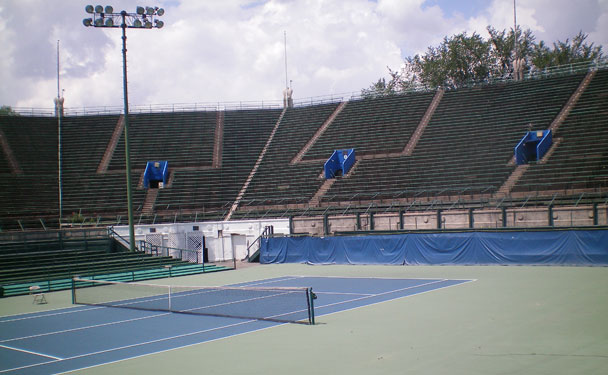There is a grass roots effort to save and preserve the historic tennis stadium at the West Side Tennis Club in Forest Hills, N.Y.
The stadium is the historic tennis venue that hosted the U.S. Open/U.S. Nationals from 1920 to 1977, but has fallen in disrepair since it last seated spectators at a professional tennis event in 1990. The club’s membership is set to vote on August 19 on whether to sell the parcel of land that features the stadium to a real estate developer, who is planning to raze the stadium and construct condos on the hallowed ground of international tennis.
No history of American tennis can be told without including the West Side Tennis Club. Many of the greatest and most historic accomplishments in the sport occurred on these hallowed grounds. The idyllic setting features hard, clay, and plush grass courts, a famed Tudor-style clubhouse and a 14,000-seat stadium, making the venue the American version of Wimbledon and the All-England Lawn Tennis Club. The West Side Tennis Club is the tennis world’s version of baseball’s Wrigley Field. In the words of Hall of Famer Billie Jean King, “Sitting there and watching the sun go down behind the stadium – you’ll never see another sight like that in tennis.”
The West Side Tennis Club stadium was built in1923, christened with the playing of the Wightman Cup matches featuring Helen Wills. The stadium was the site of the first tennis “Grand Slam” in 1938 (Don Budge clinching over Gene Mako in the U.S. singles final) and also the site of the completion of Grand Slams by Maureen Connolly (1954), Rod Laver (1962, 1969) and Margaret Court (1970). The stadium also was the site of Althea Gibson breaking the color barrier in tennis (1950) and becoming the first black athlete to win the U.S. Nationals (1957, 1958) as well as venue of Arthur Ashe’s historic 1968 US Open title, becoming the first black man to win a major title. Many of the sports all-time great tennis greats, including Jack Kramer, Pancho Gonzalez, Helen Wills Moody, Tony Trabert, Billie Jean King, Chris Evert, Stan Smith, Jimmy Connors among many others won U.S. titles on this historic turf. The stadium has also hosted more U.S. Davis Cup matches than any other venue, while also serving as the site of many memorable musical performances from acts including The Beatles, The Rolling Stones, Bob Dylan, Frank Sinatra, Diana Ross among others.

“Walking out to play Evonne Goolagong [in the 1974 Open final] and seeing the stadium full – SRO – for the first time at a women’s match. And it was a great place to sit on the clubhouse terrace and watch the sun set over that horseshoe stadium. They should find a way to use that stadium,” said Billie Jean King of Forest Hills in 2002. Said 1971 U.S. Open champion Stan Smith in 2001, “But I always tell people that I can say I won Forest Hills, and now when you say you won Flushing, it just doesn’t have the same ring.”
Wrote George Vecsey in the New York Times in 2001, The ancient stadium, where Bjorn Borg and the Beatles played — although not at the same time — is just a crumbling backdrop at the west end of the private club…Most of the old sports places get knocked down by the wrecking ball half an hour after the last fan totters out. In New York, people of a certain age get a knot in their stomach when they approach the buildings where the Polo Grounds, Ebbets Field and the previous Madison Square Garden once hunkered. The dingy old places were intimate in ways the new palaces are not. People in Chicago, Boston and New York must know how lucky they are to still be able to watch the Cubs, the Red Sox and the Yankees in their historic ballparks, despite the lack of amenities. …Forest Hills is a repository of the soul of tennis.”
Interested parties that wish to help try and prevent the sale of the stadium can participate in an urgent letter-writing campaign, which is now under way. Fans can write a letter supporting official landmark status for the stadium to Chair Tierney of the Landmarks Preservation Commission.
Many people feel that it is unfair that the board of directors of the West Side Tennis Club are alone responsible for making decision to destroy or preserve the tennis stadium while the greater public (for whom the stadium was conceived for) is being excluded. If restored and adaptively reused for concerts and smaller tennis matches, it would enhance the appeal of the Forest Hills neighborhood and preserve the historic iconic venue. Green “historic” space is rare in New York and city land-marking would preserve the historic Forest Hills Tennis Stadium, Clubhouse, grounds and interiors for future generations to cherish and increase the chances of funding for repairs.
Interested parties can e-mail the Landmarks Preservation Commission a letter requesting landmark status ASAP for the club. Contact:
– Chair Robert Tierney at rtierney@lpc.nyc.gov
– Dir of Research Mary Beth Betts at mbetts@lpc.nyc.gov
– General mailbox: comments@lpc.nyc.gov
– Rego-Forest Preservation Council Chair Michael Perlman: unlockthevault@hotmail.com
Photos, memorabilia, history (paste link into browser): http://www.flickr.com/photos/8095451@N08/sets/72157607136282297/
